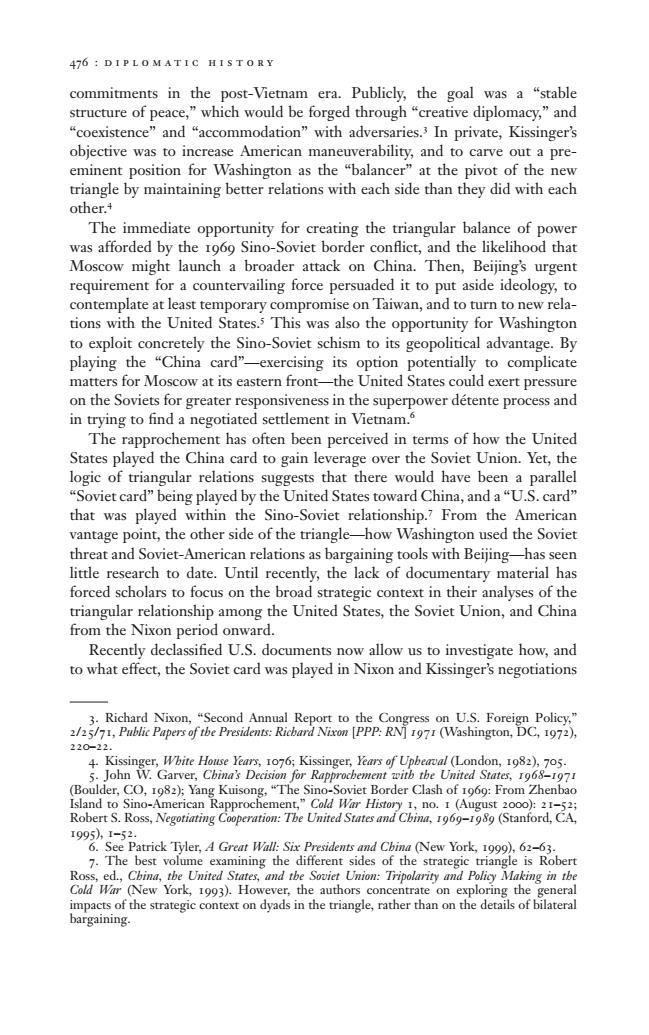正在加载图片...

476:DIPLOMATIC HISTORY commitments in the post-Vietnam era.Publicly,the goal was a "stable structure of peace,"which would be forged through "creative diplomacy,"and “coexistence”and“accommodation”with adversaries.3 In private,Kissinger's objective was to increase American maneuverability,and to carve out a pre- eminent position for Washington as the "balancer"at the pivot of the new triangle by maintaining better relations with each side than they did with each other.+ The immediate opportunity for creating the triangular balance of power was afforded by the 1969 Sino-Soviet border conflict,and the likelihood that Moscow might launch a broader attack on China.Then,Beijing's urgent requirement for a countervailing force persuaded it to put aside ideology,to contemplate at least temporary compromise on Taiwan,and to turn to new rela- tions with the United States.s This was also the opportunity for Washington to exploit concretely the Sino-Soviet schism to its geopolitical advantage.By playing the "China card"-exercising its option potentially to complicate matters for Moscow at its eastern front-the United States could exert pressure on the Soviets for greater responsiveness in the superpower detente process and in trying to find a negotiated settlement in Vietnam.5 The rapprochement has often been perceived in terms of how the United States played the China card to gain leverage over the Soviet Union.Yet,the logic of triangular relations suggests that there would have been a parallel "Soviet card"being played by the United States toward China,and a "U.S.card" that was played within the Sino-Soviet relationship.?From the American vantage point,the other side of the triangle-how Washington used the Soviet threat and Soviet-American relations as bargaining tools with Beijing-has seen little research to date.Until recently,the lack of documentary material has forced scholars to focus on the broad strategic context in their analyses of the triangular relationship among the United States,the Soviet Union,and China from the Nixon period onward. Recently declassified U.S.documents now allow us to investigate how,and to what effect,the Soviet card was played in Nixon and Kissinger's negotiations 3.Richard Nixon,"Second Annual Report to the Congress on U.S.Foreign Policy," 2/25/71,Public Papers of tbe Presidents:Ricbard Nixon [PPP:RN]197I (Washington,DC,1972), 220-22. 4.Kissinger,Wbite House Years,1076;Kissinger,Years of Upbeaval (London,1982),705. 5.John W.Garver,China's Decision for Rapprocbement with the United States,1968-1971 (Boulder,CO,1982);Yang Kuisong,"The Sino-Soviet Border Clash of 1969:From Zhenbao Island to Sino-American Rapprochement,"Cold Wir History 1,no.I (August 2000):21-52; Robert S.Ross,Negotiating Cooperation:The United States and Cbina,1969-1989(Stanford,CA, I995,1-52. 6.See Patrick Tyler,A Great Wall:Six Presidents and Cbina (New York,1999),62-63. 7.The best volume examining the different sides of the strategic triangle is Robert Ross,ed.,China,the United States,and tbe Soviet Union:Tripolarity and Policy Making in the Cold War (New York,1993).However,the authors concentrate on exploring the general impacts of the strategic context on dyads in the triangle,rather than on the details of bilateral bargaining.commitments in the post-Vietnam era. Publicly, the goal was a “stable structure of peace,” which would be forged through “creative diplomacy,” and “coexistence” and “accommodation” with adversaries.3 In private, Kissinger’s objective was to increase American maneuverability, and to carve out a preeminent position for Washington as the “balancer” at the pivot of the new triangle by maintaining better relations with each side than they did with each other.4 The immediate opportunity for creating the triangular balance of power was afforded by the 1969 Sino-Soviet border conflict, and the likelihood that Moscow might launch a broader attack on China. Then, Beijing’s urgent requirement for a countervailing force persuaded it to put aside ideology, to contemplate at least temporary compromise on Taiwan, and to turn to new relations with the United States.5 This was also the opportunity for Washington to exploit concretely the Sino-Soviet schism to its geopolitical advantage. By playing the “China card”—exercising its option potentially to complicate matters for Moscow at its eastern front—the United States could exert pressure on the Soviets for greater responsiveness in the superpower détente process and in trying to find a negotiated settlement in Vietnam.6 The rapprochement has often been perceived in terms of how the United States played the China card to gain leverage over the Soviet Union. Yet, the logic of triangular relations suggests that there would have been a parallel “Soviet card” being played by the United States toward China, and a “U.S. card” that was played within the Sino-Soviet relationship.7 From the American vantage point, the other side of the triangle—how Washington used the Soviet threat and Soviet-American relations as bargaining tools with Beijing—has seen little research to date. Until recently, the lack of documentary material has forced scholars to focus on the broad strategic context in their analyses of the triangular relationship among the United States, the Soviet Union, and China from the Nixon period onward. Recently declassified U.S. documents now allow us to investigate how, and to what effect, the Soviet card was played in Nixon and Kissinger’s negotiations 476 : diplomatic history 3. Richard Nixon, “Second Annual Report to the Congress on U.S. Foreign Policy,” 2/25/71, Public Papers of the Presidents: Richard Nixon [PPP: RN] 1971 (Washington, DC, 1972), 220–22. 4. Kissinger, White House Years, 1076; Kissinger, Years of Upheaval (London, 1982), 705. 5. John W. Garver, China’s Decision for Rapprochement with the United States, 1968–1971 (Boulder, CO, 1982); Yang Kuisong, “The Sino-Soviet Border Clash of 1969: From Zhenbao Island to Sino-American Rapprochement,” Cold War History 1, no. 1 (August 2000): 21–52; Robert S. Ross, Negotiating Cooperation: The United States and China, 1969–1989 (Stanford, CA, 1995), 1–52. 6. See Patrick Tyler, A Great Wall: Six Presidents and China (New York, 1999), 62–63. 7. The best volume examining the different sides of the strategic triangle is Robert Ross, ed., China, the United States, and the Soviet Union: Tripolarity and Policy Making in the Cold War (New York, 1993). However, the authors concentrate on exploring the general impacts of the strategic context on dyads in the triangle, rather than on the details of bilateral bargaining